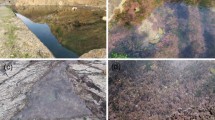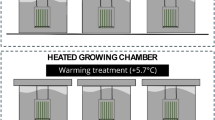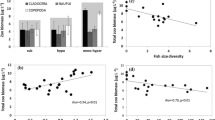Abstract
Primary productivity and respiration of the overall plankton community and of ultraplankton (organisms passing through a 3-μm Nuclepore filter) were studied at the entrance to the Gulf of Finland during the growth season in 1982. Data of the respiration measurements from previous years are also presented. During the development of a diatom spring bloom, the algal component could be successfully separated from the bacterial component by size fractionation with a 3-μm Nuclepore filter and thus the “algal” respiration could be approximated, being on the order of 10 to 20% of the gross production. After the phytoplankton spring maximum, bacteria played an important role in mediating the energy flow from phytoplankton exudates to higher trophic levels. Maximum values of 1 230 and 740 mg O2 m-2 d-1 were recorded for overall and for ultraplankton respiration, respectively, during late July. High productivity values coupled with low phytoplankton biomass and low inorganic nutrient values were also recorded in late July, indicating effective nutrient regeneration and rapid turnover of the plankton community. During late summer, a considerable fraction (over 30%) of phytoplankton production was released as exudates, suggesting that much of the energy is channeled to higher trophic levels via bacterial pathways rather than by direct herbivorous grazing during this season. The summer development of phytoplankton community structure and functioning is strongly controlled by hydrographic conditions, i.e. by nutrient inputs via upwelling and by water temperature. A carbon budget for late summer indicated that bacteria may contribute only up to 50% of the overall respiration of the plankton community, which suggests that heterotrophs other than bacteria play an important role in nutrient regeneration. The present study stresses the importance of energy flow via the phytoplankton exudatebacteria-micrograzer pathway in relatively oligotrophic, brackish water ecosystems.
Similar content being viewed by others
Literature cited
Azam, F., T. Fenchel, J. G. Field, J. S. Gray, L. A. Meyer-Reil and F. Thingstad: The ecological role of water-column microbes in the sea. Mar. Ecol. Prog. Ser. 10, 257–263 (1983).
Azam, F. and O. Holm-Hansen: Use of tritiated substrates in the study of heterotrophy in seawater. Mar. Biol. 23, 191–196 (1973).
Banse, K.: Rates of growth, respiration and photosynthesis of unicellular algae as related to cell size — a review. J. Phycol. 12, 135–140 (1976)
Bell, R. T. and J. Kuparinen: Assessing phytoplankton and bacterioplankton production during early spring in Lake Erken Sweden. Appl. envir. Microbiol. 48, 1221–1230 (1984)
Davies, J. M. and P. J. LeB. Williams: Verification of 14C and O2 derived primary organic production measurements using an enclosed ecosystem. J. Plank. Res. 6, 457–474 (1984).
Dring, M. J. and D. H. Jewson: What does 14C uptake by phytoplankton really measure? A theoretical modelling approach. Proc. R. Soc. Lond. B 214, 351–368 (1982).
Edler, L. (ed.): Recommendations on methods for marine biological studies in the Baltic Sea, phytoplankton and chlorophyll. Baltic mar. Biol. Publ. 5, 1–38 (1979)
Ferguson, R. L. and P. Rublee: Contribution of bacteria to standing crop of coastal plankton. Limnol Oceanogr. 21, 141–145 (1976)
Gocke, K.: A comparison of methods for determining the turnover times of dissolved organic compounds. Mar. Biol. 42, 131–141 (1977)
Hagström, and U. Larsson: Diel and seasonal variation in growth rates of pelagic bacteria. In: Heterotrophic activity in the sea, pp 249–261. Ed. by J. E. Hobbie and P. J. LeB. Williams. New York: Plenum Press 1984
Heyman, U. and P. Blomqvist: Diurnal variations in phytoplankton cell numbers and primary productivity in Siggeforasjön. Arch. Hydrobiol. 100, 219–233 (1984)
Hobson, L. A., W. J. Morris and K. T. Pirquet: Theoretical and experimental analysis of the 14C technique and its use in studies of primary production. J. Fish. Res. Bd Can. 33, 1715–1721 (1976)
Huttunen, M. and J. Kuparinen: Species succession and productivity of ultraphytoplankton in the pelagial off Tvärminne, SW coast of Finland. Ophelia Suppl. 4, 73–83 (1986)
Hällfors, S. and G. Hällfors: Phytoplankton of the Pojo Bay and the Tammisaari-Tvärminne area on 05. 0.8 1982. Länsi-Uudenmaan Vesiensuojeluyhdistys r.y. Report 26, 1–42 (1983) (in Finnish)
Kononen, K., M. Forrskåhl, M. Huttunen, M. Sandell and H. Viljamaa: Practical problems encountered in phytoplankton cell volume calculations using the BMB recommendations in the Gulf of Finland. Limnologica (Berlin) 15, 605–614 (1984)
Kononen, K. and Å. Niemi: Long-term variation of the phytoplankton composition at the entrance to the Gulf of Finland. Ophelia, suppl. 3, 101–110 (1984)
Kuparinen, J.: Comparison of the oxygen and 14C methods to measure phytoplankton production rates: evaluation of the photosynthetic quotient. Verh. int. Ver. Limnol. 22, 2208–2213 (1984)
Kuparinen, J., K. Lahti, T. Talsi, T. Tamminen and A. Virtanen: Determination of the Michaelis-Menten kinetic parameters with single concentration assays. Publ. Water Res. Inst. National Board of Water, Finland. 56, 26–34 (1984b)
Kuparinen, J., J.-M. Leppänen, J. Sarvala, A. Sundberg and A. Virtanen: Production and utilization of organic matter in a Baltic ecosystem off Tvärminne, southwest coast of Finland. Rapp. P.-v. Reun. Cons. int. Explor. Mer 183, 180–192 (1984a)
Lassig, J., J-M. Leppänen and G. Tamelander: Phytoplankton primary production and related factors in the Tvärminne sea area in 1972–1979 as compared with other partis of the Gulf of Finland. 12th Conference of the Baltic Oceanographers, Leningrad, 14–17 April 1980. 14 pp. (mimeo) 1980
Laws, E. A.: The importance of respiration losses in controlling the size distribution of marine phytoplankton Ecology 56, 419–426 (1975)
Lindholm, T.: On the ecology of Mesodinium rubrum (Lohmann) (Ciliata) in a stagnant brackish basin on Åland, SW Finland. Kiel. Meeresforsch., Sonderh. 5, 117–123 (1981)
Marcussen, B., P. Nielsen and M. Jeppesen: Diel changes in bacterial activity determined by means of microautoradiography. Arch. Hydrobiol. Beih. Ergebn. Limnol. 19, 141–149 (1984)
Niemi, Å.: Ecology of phytoplankton in the Tvärminne area, SW coast of Finland. I. Dynamics of hydrography, nutrients, chlorophyll-a and phytoplankton. Acta Bot. Fennica 100, 1–68 (1973)
Niemi, Å.: Ecology of phytoplankton in the Tvärminne area, SW coast of Finland. II. Primary production and environment conditions in the archipelago zone and the sea zone. Acta Bot. Fennica 105, 1–73 (1975)
Niemi, M., J. Kuparinen, A. Uusi-Rauva and K. Korhonen: Preparation of 14C-labeled algal samples for liquid scintillation counting. Hydrobiologia 106, 149–156 (1983)
Peterson, B. J.: Aquatic primary productivity and the 14C−CO2 method: a history of the productivity problem. A. Rev. Ecol. Syst. 11, 359–385 (1980)
Riemann, B., P. Nielsen, M. Jeppesen, B. Marcussen and J. A. Fuhrmann: Diel changes in bacterial biomass and growth rates in coastal environments, determined by means of thymidine incorporation into DNA, frequency of dividing cells (FDC), and microautoradiography. Mar. Ecol. Prog. Ser. 17, 227–235 (1984)
Salonen, K. and K. Kononen: Applicability of size fractionation to assess respiration in different size classes of plankton. Arch. Hydrobiol. Beih. Ergebn. Limnol. 19, 223–227 (1984)
SFS-catalogue 1055: Finnish Standard Association, Helsinki 1981
Steemann Nielsen, E.: The use of radio-active carbon (14C) for measuring organic production in the sea. J. Cons. perm. int. Explor. Mer 18, 117–140 (1952)
Tamminen, T., S. Kaitala, K. Kivi and J. Kuparinen: Response of a planktonic brackish water community to single and combined additions of ammonium and phosphate in a factorial mesocosm experiment. In: Marine biology of polar regions and effects of stress on marine organisms. pp 363–378. Ed. by J. S. Gray and M. E. Christiansen. Chichester: John Wiley and Sons Ltd. 1985
Utermöhl, H.: Zur Vervollkommnung der quantitativen Phytoplankton Methodik. Mitt. int. Ver. Limnol. 9, 1–38 (1958)
Virtanen, A.: Numbers, biomass and productivity of bacteria in a coastal brackish water, SW Finland. Aqua Fennica 15, 143–160 (1985)
Väätänen, P.: Microbial activity in brackish water determined as oxygen consumption. Arch. Hydrobiol. Ergebn. Limnol. 12, 32–37 (1979)
Väätänen, P.: Factor analysis of the impact of environment on microbial communities in the Tvärminne area, southern coast of Finland. Appl. envir. Microbiol. 40, 55–61 (1980)
Watson, S. W., Novitsky, H. L. Quinbay and F. W. Valois: Determination of bacterial number and biomass in the marine environment. Appl. envir. Microbiol. 33, 954 (1977)
Williams, P. J. Le B.: Incorporation of microheterotrophic process into the classical paradigm of the planktonic food web. Kiel. Meeresforsch., Sonderh. 5, 1–28 (1981 a)
Williams, P. J. Le B.: Microbial contribution to overall plankton community respiration-studies in enclosures. In: Marine mesocosms, pp 305–321. Ed. by G. D. Grice and M. P. Reeve. Berlin: Springer Verlag 1981 b
Williams, P. J. Le B.: A review of measurements of respiration rates of marine plankton populations. In: Heterotrophic activity in the sea, pp 357–389. Ed. by J. E. Hobbie and P. J. LeB. Williams. New York: Plenum Press 1984
Williams, P. J. Le B., K. R. Heinemann, J. Marra and D. A. Purdie: Comparison of 14C and O2 measurements of phytoplankton production in oligotrophic waters. Nature, Lond. 305, 49–50 (1983)
Williams, P. J. Le B., R. C. T. Raine and J. R. Bryan: Agreement between the 14C and oxygen methods of measuring phytoplankton production: reassessment of the photosynthetic quotient. Oceanologica Acta 2, 411–416 (1979)
Wright, R. T.: Dynamics of pools of dissolved organic carbon. In: Heterotrophic activity in the sea, pp 121–153. Ed. by J. E. Hobbie and P. J. Le B. Williams. New York: Plenum Press 1984
Wright, R. T. and B. K. Burnison: Heterotrophic activity measured with radiolabelled organic substrates. In: Native aquatic bacteria: enumeration, activity and ecology, pp 140–155. Ed. by Costerton and Colwell. Philadelphia: American Society for Testing and Materials, STP 695, 1979
Wright, R. T. and J. E. Hobbie: Use of glucose and acetate by bacteria and algae in aquatic ecosystems. Ecology 47, 447–464 (1966)
Author information
Authors and Affiliations
Additional information
Communicated by T. Fenchel, Aarhus
Rights and permissions
About this article
Cite this article
Kuprinen, J. Production and respiration of overall plankton and ultraplankton communities at the entrance to the Gulf of Finland in the Baltic Sea. Mar. Biol. 93, 591–607 (1987). https://doi.org/10.1007/BF00392797
Accepted:
Issue Date:
DOI: https://doi.org/10.1007/BF00392797




